动词的时态 一般现在时
- 格式:doc
- 大小:101.50 KB
- 文档页数:10
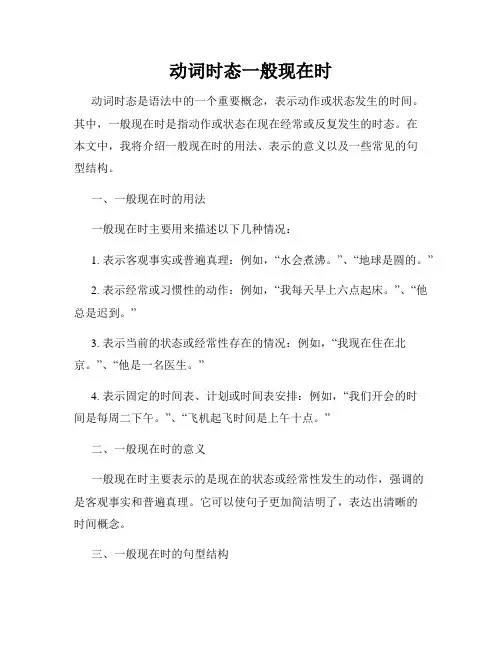
动词时态一般现在时动词时态是语法中的一个重要概念,表示动作或状态发生的时间。
其中,一般现在时是指动作或状态在现在经常或反复发生的时态。
在本文中,我将介绍一般现在时的用法、表示的意义以及一些常见的句型结构。
一、一般现在时的用法一般现在时主要用来描述以下几种情况:1. 表示客观事实或普遍真理:例如,“水会煮沸。
”、“地球是圆的。
”2. 表示经常或习惯性的动作:例如,“我每天早上六点起床。
”、“他总是迟到。
”3. 表示当前的状态或经常性存在的情况:例如,“我现在住在北京。
”、“他是一名医生。
”4. 表示固定的时间表、计划或时间表安排:例如,“我们开会的时间是每周二下午。
”、“飞机起飞时间是上午十点。
”二、一般现在时的意义一般现在时主要表示的是现在的状态或经常性发生的动作,强调的是客观事实和普遍真理。
它可以使句子更加简洁明了,表达出清晰的时间概念。
三、一般现在时的句型结构在使用一般现在时时,需要注意动词的变化情况。
一般现在时的动词变化规则如下:1. 对于第三人称单数(he, she, it)以及单数名词做主语的情况,动词要加上-s或-es结尾:例如,“She plays tennis every Sunday.”、“The cat eats fish.”2. 对于一般的主语(I, you, we, they)或复数名词做主语的情况,动词不做变化:例如,“We study English at school.”、“Dogs like to play.”一般现在时的句型结构有以下几种:1. 肯定句:主语 + 动词原形/动词+s/es + 其他成分。
例如,“I love watching movies.”、“They go to school by bus.”2. 否定句:主语 + do/does not + 动词原形 + 其他成分。
例如,“He does not like coffee.”、“We do not play basketball.”3. 一般疑问句:Do/Does + 主语 + 动词原形 + 其他成分?例如,“Do you speak English?”、“Does she go to the gym?”4. 特殊疑问句:疑问词 + do/does + 主语 + 动词原形 + 其他成分?例如,“Where do you live?”、“What does he do for a living?”四、一般现在时的常见用法一般现在时在日常生活中非常常见,以下是一些常用的用法和句子示例:1. 表示经常性的活动:I usually go to the gym on Saturdays.(我通常在周六去健身房。
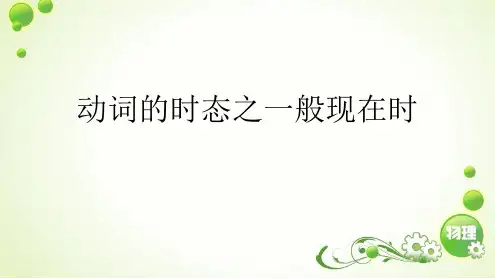
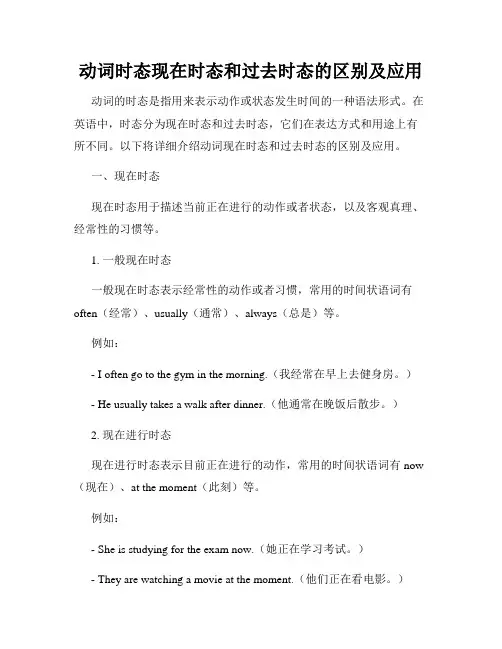
动词时态现在时态和过去时态的区别及应用动词的时态是指用来表示动作或状态发生时间的一种语法形式。
在英语中,时态分为现在时态和过去时态,它们在表达方式和用途上有所不同。
以下将详细介绍动词现在时态和过去时态的区别及应用。
一、现在时态现在时态用于描述当前正在进行的动作或者状态,以及客观真理、经常性的习惯等。
1. 一般现在时态一般现在时态表示经常性的动作或者习惯,常用的时间状语词有often(经常)、usually(通常)、always(总是)等。
例如:- I often go to the gym in the morning.(我经常在早上去健身房。
)- He usually takes a walk after dinner.(他通常在晚饭后散步。
)2. 现在进行时态现在进行时态表示目前正在进行的动作,常用的时间状语词有now (现在)、at the moment(此刻)等。
例如:- She is studying for the exam now.(她正在学习考试。
)- They are watching a movie at the moment.(他们正在看电影。
)3. 现在完成时态现在完成时态用于表示过去发生的动作对当前造成的影响或者状态的持续性,常用的时间状语词有recently(最近)、lately(最近)、already(已经)等。
例如:- I have finished my homework.(我已经完成作业了。
)- They have traveled to many countries recently.(他们最近去了很多国家。
)二、过去时态过去时态用来表示在过去某个特定时间发生的动作。
1. 一般过去时态一般过去时态用于过去的某个时间发生的动作,常用的时间状语词有yesterday(昨天)、last week(上周)等。
例如:- I visited my grandparents yesterday.(昨天我去看望了我的祖父母。

动词时态一、一般现在时am/is/are does意义:1、经常做(usually; sometimes ; often;);2、时间或条件状语从句中(if /unless/when/once/as soon as),从句用一般现在时,主句用将来时;eg: If it rains , we will not go to the park.;I will return this book to you as soon as I finish it二、一般过去是:was/ were; did ; used to do ;would do意义:1、过去发生的或过去经常做的(in 1980/yesterday/the other day前几天);过去相继发生的动作;eg Yesterday evening I opened the door, put down my bag and found that my computer was stolen.; Lucy used to exercise every day when she was at college.三、一般将来时:will be /will do /be going to do / be to do/ be about to do 意义:将要发生的动作(in the future/ tomorrow/soon很快);现在相信、认为会发生什么(believe相信/expect期望/suppose认为)eg: I will finish my homework soon,;We believe China will become one of the most powerful countries in the world.It it said that the building is to be completed in August next year.四过去将来时would do was/were to do意义:过去认为将会发生什么I thought she would marry Tom, but she didn’t.五现在完成时have/ has done意义:1、一个动作刚刚完成或一个动作好久没有发生了(already/ in the past few years/since/till now/for 3 years/up to now);Nancy has been away from her hometown for 5 years.Is there my letter? I haven’t heard from her for a long time2、过去的动作对现在造成了影响;Who has parked his car outside my door, it is bloking my way.3、第几次做什么,或已经做..几次了;(it is the first/ third time that I have …/ I have done….twice)It is my first time that I have visitied his home.六过去完成时had done意义:1、过去发生的两个动作,有先后之分,较早发生的动作用过去完成时;He didn’t arrive until the game had began2、过去本打算或期望做...而未能实现(hope/want/expect/suppose)Lucy had expected that Tom would come but he didn’t.3、出现by the end of /by the time +过去的一个时间到….时间为止By the end of last year, another new gymnasium had been completed.七将来完成时will have done意义:从现在到将来一段时间才能完成的动作关键词:by the end of /by the time +将来的时间The writer will have completed his novel by the end of 2015八现在进行时(is/ are doing )意义:1、正在做或目前阶段都在做的事;(now/look!listen)2、表达赞美或厌烦的情绪(always/constantly/)eg: Why are you angry? ----Tom is always laughing at me九过去进行时was /were doing意义:1、过去的某个时间点发生的事情;The telephone was ringing when I opened the door.2、过去一直在做;all the time/ all the afternoon.What did you do yesterday. ----we were discussing the problem all the afternoon yesterday.3、表达赞美或厌烦十将来进行时will be doing意义:将来的某个时间点在做的事情then (那时)Lucy , l et’s go to the movie tomorrow 7pm?Oh , sorry , I will be helping my mother do housework then.十一现在完成进行时(have been doing)意义:从过去到现在一直都在做Why are you so tired?I have been painting all day long today.。

初中动词的时态与语态动词是语言中最基本的词类之一,它用来表达动作、状态和行为。
在英语中,动词的时态和语态是非常重要的语法概念。
掌握动词的时态和语态对于我们正确使用动词、准确表达意思至关重要。
本文将对初中动词的时态和语态进行详细介绍。
一、动词的时态时态是指动词所表示动作、状态或者事实发生的时间。
英语中常见的时态有一般现在时、一般过去时、一般将来时、现在进行时、过去进行时、将来进行时、现在完成时、过去完成时、将来完成时等多种时态。
1. 一般现在时(Simple Present Tense)一般现在时表示经常性或者客观事实,常用来表达日常的习惯、科学事实、真理等等。
它的基本构成为主语 + 动词原形。
例如:- They play basketball every Sunday.(他们每周日打篮球。
)- Water boils at 100 degrees Celsius.(水在100摄氏度沸腾。
)2. 一般过去时(Simple Past Tense)一般过去时表示过去发生的动作或者状态,常用于叙述过去的经历或者事件。
它的基本构成为主语 + 动词过去式。
例如:- I visited my grandparents last weekend.(我上个周末去看望了我的祖父母。
)- She didn't go to school yesterday.(她昨天没有去上学。
)3. 一般将来时(Simple Future Tense)一般将来时表示将来要发生的动作或者状态,常用于表达计划、打算、预测等等。
它的基本构成为主语 + will + 动词原形。
例如:- We will have a party next Friday.(我们下周五要举办一个聚会。
)- She won't come to the meeting tomorrow.(她明天不会来参加会议。
)4. 现在进行时(Present Continuous Tense)现在进行时表示正在进行的动作,通常用于描述当前正在发生的事情。

小学英语语法时态一般现在时一般现在时(Simple Present Tense)是英语语法中最基本的一种时态,表示目前正发生的动作、存在的状态或经常性的动作。
以下是关于一般现在时的相关用法和规则。
一、动词的变化:一般现在时中,动词的第三人称单数形式(he、she、it等)需加上-s或-es。
例如:- I play football.(我踢足球。
)- She cooks dinner.(她做晚饭。
)- He watches TV.(他看电视。
)但是,以下情况除外:1. 当动词以某些字母结尾时,在动词后面直接加上-s,而不再加-es。
这些字母包括:-o(goes)、-ss(passes)、-x(fixes)、-ch(watches)、-sh(rushes)等。
例如:- She goes to school.(她去上学。
)- He passes the exam.(他通过了考试。
)2. 当动词以辅音字母+y结尾时,要将y改为i,再加-es。
例如:- He studies English.(他学习英语。
)- She tries her best.(她尽力。
)第1页/共4页3. 当动词以-e结尾时,只需加上-s。
例如:- They write letters.(他们写信。
)- He can dance.(他会跳舞。
)二、用法:1. 描述客观事实或经常性动作:一般现在时常用于描述客观事实或经常性动作。
例如:- Water boils at 100 degrees Celsius.(水沸腾的温度是100摄氏度。
)- I usually go to bed at 10 o'clock.(我通常在10点钟上床睡觉。
)2. 描述现阶段的状态:一般现在时还可用来描述现阶段的状态或对现实情况的评论。
例如:- They live in New York.(他们住在纽约。
)- She looks tired.(她看起来很累。
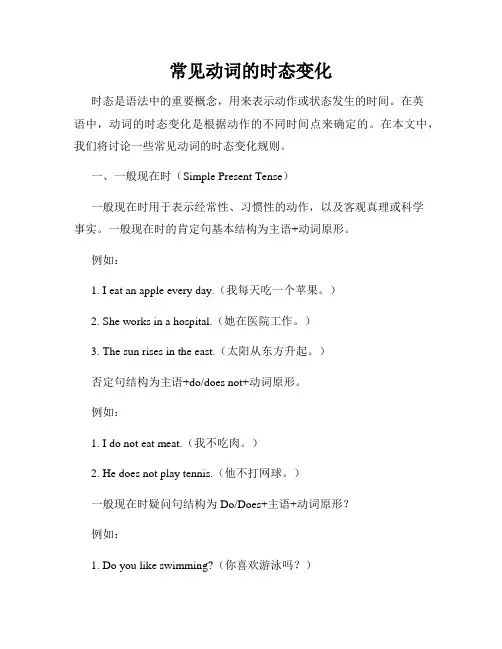
常见动词的时态变化时态是语法中的重要概念,用来表示动作或状态发生的时间。
在英语中,动词的时态变化是根据动作的不同时间点来确定的。
在本文中,我们将讨论一些常见动词的时态变化规则。
一、一般现在时(Simple Present Tense)一般现在时用于表示经常性、习惯性的动作,以及客观真理或科学事实。
一般现在时的肯定句基本结构为主语+动词原形。
例如:1. I eat an apple every day.(我每天吃一个苹果。
)2. She works in a hospital.(她在医院工作。
)3. The sun rises in the east.(太阳从东方升起。
)否定句结构为主语+do/does not+动词原形。
例如:1. I do not eat meat.(我不吃肉。
)2. He does not play tennis.(他不打网球。
)一般现在时疑问句结构为Do/Does+主语+动词原形?例如:1. Do you like swimming?(你喜欢游泳吗?)2. Does she speak English?(她会说英语吗?)二、一般过去时(Simple Past Tense)一般过去时用于表示过去发生的动作或状态。
一般过去时的肯定句基本结构为主语+动词过去式。
例如:1. He played football yesterday.(他昨天踢足球。
)2. We went to the beach last summer.(我们去年夏天去了海滩。
)否定句结构为主语+did not+动词原形。
例如:1. I did not finish my homework.(我没完成我的作业。
)2. She did not watch the movie.(她没看这部电影。
)一般过去时疑问句结构为Did+主语+动词原形?例如:1. Did you see him yesterday?(你昨天见到他了吗?)2. Did they go shopping together?(他们一起去购物了吗?)三、一般将来时(Simple Future Tense)一般将来时用于表示将来发生的动作或状态。
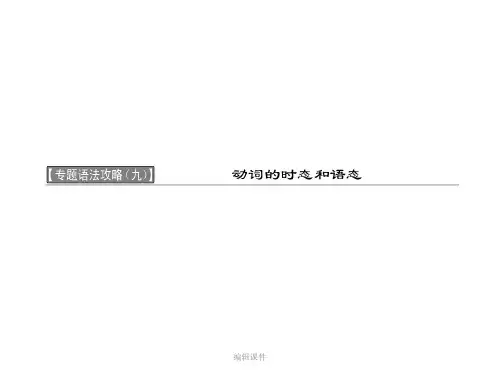
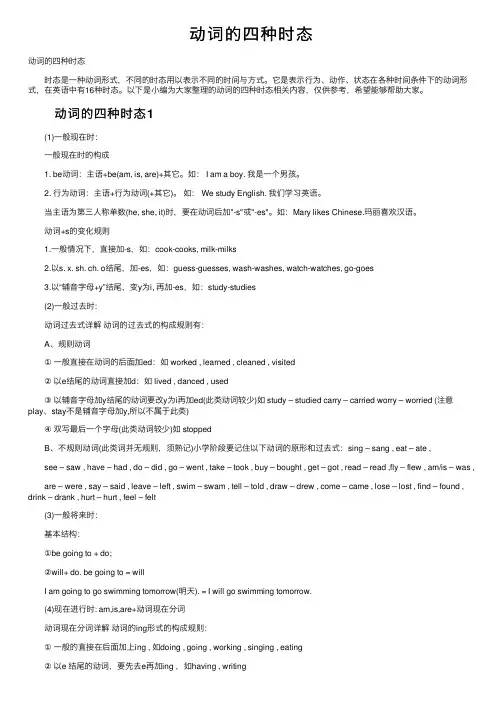
动词的四种时态动词的四种时态 时态是⼀种动词形式,不同的时态⽤以表⽰不同的时间与⽅式。
它是表⽰⾏为、动作、状态在各种时间条件下的动词形式,在英语中有16种时态。
以下是⼩编为⼤家整理的动词的四种时态相关内容,仅供参考,希望能够帮助⼤家。
动词的四种时态1 (1)⼀般现在时: ⼀般现在时的构成 1. be动词:主语+be(am, is, are)+其它。
如: I am a boy. 我是⼀个男孩。
2. ⾏为动词:主语+⾏为动词(+其它)。
如: We study English. 我们学习英语。
当主语为第三⼈称单数(he, she, it)时,要在动词后加"-s"或"-es"。
如:Mary likes Chinese.玛丽喜欢汉语。
动词+s的变化规则 1.⼀般情况下,直接加-s,如:cook-cooks, milk-milks 2.以s. x. sh. ch. o结尾,加-es,如:guess-guesses, wash-washes, watch-watches, go-goes 3.以“辅⾳字母+y”结尾,变y为i, 再加-es,如:study-studies (2)⼀般过去时: 动词过去式详解动词的过去式的构成规则有: A、规则动词 ①⼀般直接在动词的后⾯加ed:如 worked , learned , cleaned , visited ②以e结尾的动词直接加d:如 lived , danced , used ③以辅⾳字母加y结尾的动词要改y为i再加ed(此类动词较少)如 study – studied carry – carried worry – worried (注意play、stay不是辅⾳字母加y,所以不属于此类) ④双写最后⼀个字母(此类动词较少)如 stopped B、不规则动词(此类词并⽆规则,须熟记)⼩学阶段要记住以下动词的原形和过去式:sing – sang , eat – ate , see – saw , have – had , do – did , go – went , take – took , buy – bought , get – got , read – read ,fly – flew , am/is – was , are – were , say – said , leave – left , swim – swam , tell – told , draw – drew , come – came , lose – lost , find – found , drink – drank , hurt – hurt , feel – felt (3)⼀般将来时: 基本结构: ①be going to + do; ②will+ do. be going to = will I am going to go swimming tomorrow(明天). = I will go swimming tomorrow. (4)现在进⾏时: am,is,are+动词现在分词 动词现在分词详解动词的ing形式的构成规则: ①⼀般的直接在后⾯加上ing , 如doing , going , working , singing , eating ②以e 结尾的动词,要先去e再加ing ,如having , writing ③双写最后⼀个字母的(此类动词极少)有:running , swimming , sitting , getting 动词的四种时态2 ⼀般现在时 主要⽤来表⽰⼈、事物的现在状况和特点;表⽰经常或习惯性的动作,句⼦中常有often, always, from time to time 等时间状语;表⽰客观规律和永恒真理等。
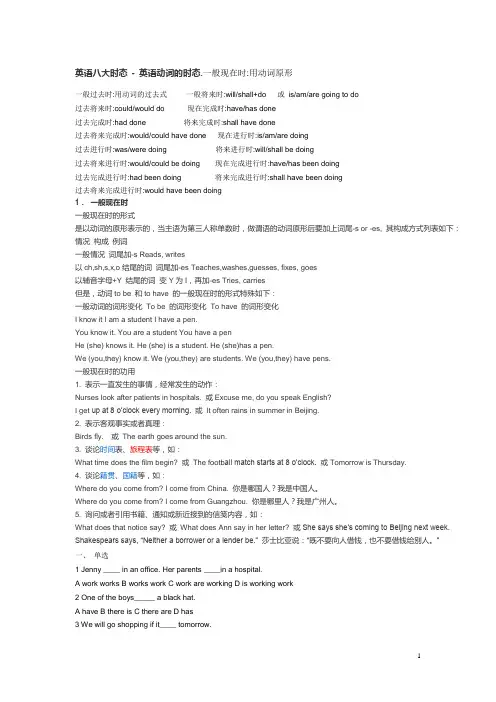
英语八大时态- 英语动词的时态.一般现在时:用动词原形一般过去时:用动词的过去式一般将来时:will/shall+do 或is/am/are going to do过去将来时:could/would do 现在完成时:have/has done过去完成时:had done 将来完成时:shall have done过去将来完成时:would/could have done 现在进行时:is/am/are doing过去进行时:was/were doing 将来进行时:will/shall be doing过去将来进行时:would/could be doing 现在完成进行时:have/has been doing过去完成进行时:had been doing 将来完成进行时:shall have been doing过去将来完成进行时:would have been doing1.一般现在时一般现在时的形式是以动词的原形表示的,当主语为第三人称单数时,做谓语的动词原形后要加上词尾-s or -es, 其构成方式列表如下:情况构成例词一般情况词尾加-s Reads, writes以ch,sh,s,x,o结尾的词词尾加-es Teaches,washes,guesses, fixes, goes以辅音字母+Y 结尾的词变Y为I,再加-es Tries, carries但是,动词to be 和to have 的一般现在时的形式特殊如下:一般动词的词形变化To be 的词形变化To have 的词形变化I know it I am a student I have a pen.You know it. You are a student You have a penHe (she) knows it. He (she) is a student. He (she)has a pen.We (you,they) know it. We (you,they) are students. We (you,they) have pens.一般现在时的功用1. 表示一直发生的事情,经常发生的动作:Nurses look after patients in hospitals. 或Excuse me, do you speak English?I get up at 8 o’clock every morning. 或It often rains in summer in Beijing.2. 表示客观事实或者真理:Birds fly. 或The earth goes around the sun.3. 谈论时间表、旅程表等,如:What time does the film begin? 或The footb all match starts at 8 o’clock. 或Tomorrow is Thursday.4. 谈论籍贯、国籍等,如:Where do you come from? I come from China. 你是哪国人?我是中国人。
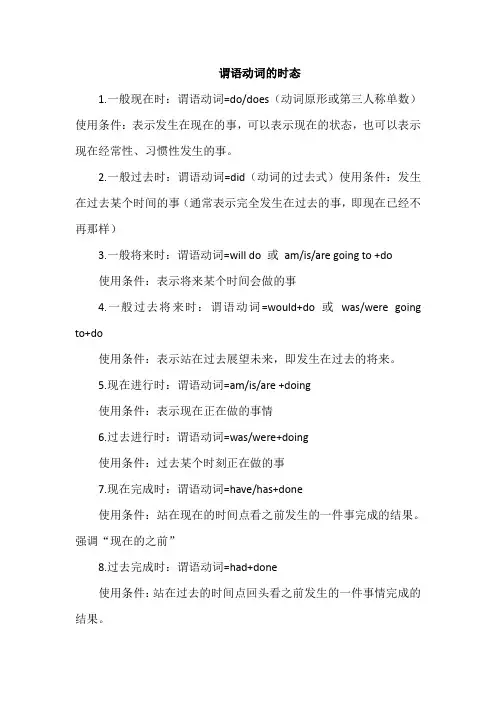
谓语动词的时态
1.一般现在时:谓语动词=do/does(动词原形或第三人称单数)使用条件:表示发生在现在的事,可以表示现在的状态,也可以表示现在经常性、习惯性发生的事。
2.一般过去时:谓语动词=did(动词的过去式)使用条件:发生在过去某个时间的事(通常表示完全发生在过去的事,即现在已经不再那样)
3.一般将来时:谓语动词=will do 或am/is/are going to +do
使用条件:表示将来某个时间会做的事
4.一般过去将来时:谓语动词=would+do 或was/were going to+do
使用条件:表示站在过去展望未来,即发生在过去的将来。
5.现在进行时:谓语动词=am/is/are +doing
使用条件:表示现在正在做的事情
6.过去进行时:谓语动词=was/were+doing
使用条件:过去某个时刻正在做的事
7.现在完成时:谓语动词=have/has+done
使用条件:站在现在的时间点看之前发生的一件事完成的结果。
强调“现在的之前”
8.过去完成时:谓语动词=had+done
使用条件:站在过去的时间点回头看之前发生的一件事情完成的结果。
动词时态复习一般现在时和一般过去时动词时态复习:一般现在时和一般过去时动词的时态是用来表示动作或状态发生的时间。
在英语中,一般现在时和一般过去时是最基本的两种时态。
本文将对这两种时态进行复习和讲解。
一、一般现在时一般现在时用来表示经常性的、习惯性的或普遍的动作或状态。
它的构成通常是主语 + 动词原形(第三人称单数要加-s)。
1. 表示经常性的动作或状态例如:- I go to school every day.(我每天上学。
)- She drinks coffee in the morning.(她早上喝咖啡。
)2. 表示习惯性的动作或状态例如:- They often play football on weekends.(他们经常在周末踢足球。
)- We usually have lunch at 12 o'clock.(我们通常在12点吃午饭。
)3. 表示客观事实或普遍真理例如:- The sun rises in the east.(太阳从东方升起。
)- Water boils at 100 degrees Celsius.(水在100摄氏度沸腾。
)二、一般过去时一般过去时用来表示过去发生的动作或状态。
它的构成通常是主语+ 动词过去式。
1. 表示过去的动作或状态例如:- I visited my grandparents last weekend.(上周末我去看望了我的祖父母。
)- She studied English for three hours yesterday.(昨天她学了三个小时英语。
)2. 表示过去的经常性动作或状态例如:- When I was a child, I played with my friends every day.(我小时候,我每天都和朋友们一起玩。
)- We lived in that house for five years.(我们在那个房子里住了五年。
动词时态一般现在时的用法动词时态是指用动词来表示动作或状态的时间和状态变化。
一般现在时是动词的一种基本时态,用来表示经常性、习惯性或普遍性的动作或状态。
本文将介绍动词时态一般现在时的用法和例句。
一、陈述句的一般现在时用法1. 表示客观真理或自然规律:动作或状态是普遍存在、经常发生或永远如此。
示例:- The sun rises in the east.(太阳从东方升起。
)- Water boils at 100 degrees Celsius.(水烧开的温度为摄氏100度。
)2. 表示经常性或习惯性的动作:作为习惯、常态或例行动作,经常反复发生。
示例:- I walk to work every day.(我每天步行去上班。
)- She always drinks coffee in the morning.(她每天早上都喝咖啡。
)3. 表示现阶段的状态或情况:陈述目前存在的状况或状态。
示例:- He lives in Beijing.(他住在北京。
)- They play basketball every weekend.(他们每个周末打篮球。
)二、疑问句的一般现在时用法1. 用于直接疑问句,表示询问现阶段或经常性的动作或状态。
示例:- Do you like ice cream?(你喜欢冰淇淋吗?)- Does she go to the gym every day?(她每天都去健身房吗?)2. 用于特殊疑问句,表示询问方式、原因、时间、地点、人物等。
示例:- How do you spell your name?(你的名字怎么拼写?)- Why does he always arrive late?(他为什么总是迟到?)三、否定句的一般现在时用法1. 在动词前加“do not”或“does not”表示否定。
示例:- I do not eat meat.(我不吃肉。
)- She does not like horror movies.(她不喜欢恐怖电影。
英语一般现在时动词用法全解英语中的动词时态非常重要,而一般现在时 (Simple Present Tense)是最基本的时态之一。
我们来全面解析一下英语一般现在时动词的用法。
一、动词的基本形式在一般现在时中,动词使用原形,即基本形式,不加任何变化。
例如:1. I study English every day. (我每天学习英语。
)2. They play football on weekends. (他们周末踢足球。
)3. She works in a hospital. (她在一家医院工作。
)二、第三人称单数形式在第三人称单数形式中,动词要加上-s 或 -es 结尾。
其中大部分动词只需加上 -s,而以下情况例外:1. 以辅音字母+ y 结尾的动词,在第三人称单数形式中,变为-ies。
例如:- study → studies (学习)- fly → flies (飞)2. 以 -s, -sh, -ch, -x, -o 结尾的动词,在第三人称单数形式中,变为 -es。
例如:- miss → misses (错过)- watch → w atches (观看)请注意以下动词特殊变化形式:1. have → has2. do → does3. go → goes4. can → can(无变化)5. want → wants例句:1. He reads a book every night. (他每晚读一本书。
)2. She teaches English at a school. (她在一所学校教英语。
)3. My mother cooks delicious meals. (我的妈妈做的饭菜很好吃。
)三、动词用于否定句和疑问句在否定句和疑问句中,需要使用助动词 do 或 does。
同时需要注意下列规则:1. 在否定句中,将 do not 或 does not 放在动词前面。
例如:- I do not study French. (我不学法语。
动词时态变化规则时态是语法中一个重要的概念,它用来表示动作或状态发生的时间。
在英语中,动词时态的变化规则较为复杂,涉及到不同的时态形式和时态动词的变化。
本文将介绍一些常见的动词时态变化规则,帮助读者更好地理解和运用英语时态。
一、一般现在时(Simple Present)一般现在时用来表示经常性、习惯性或普遍性的动作或状态。
动词在第三人称单数形式下要加 -s 或 -es 结尾。
1. 主语为第一、二人称或复数形式时,动词不做任何变化。
例:I love playing basketball.例:They often go hiking on weekends.2. 主语为第三人称单数形式时,动词要加 -s 或 -es 结尾。
例:She likes to read novels.例:The dog barks at strangers.3. 特殊情况:- 动词以 -sh、-ch、-s、-x 或 -o 结尾,时态变化规则为动词 + -es。
例:He watches TV every evening.例:My father fixes the car himself.- 动词以辅音字母 + y 结尾,将 y 改为 i,加 -es。
例:She studies hard for the exam.例:He tries his best to solve the problem.二、一般过去时(Simple Past)一般过去时用来表示过去发生的动作或状态。
一般过去时的动词大部分是在动词原形末尾加 -ed。
不规则动词有自己的过去时形式。
1. 动词以辅音字母 + y 结尾,将 y 改为 i,加 -ed。
例:He studied English literature in university.例:They carried the heavy boxes into the truck.2. 动词以 -e 结尾,直接加 -d。
动词的一般现在时动词的一般现在时(Simple Present Tense)是英语中最基本的时态之一,表示经常性、习惯性或普遍真实的动作、状态或事实。
本文将从基本用法、句子结构及一些常见的注意事项等方面进行探讨。
一、基本用法一般现在时用来描述经常性或习惯性的动作、状态或事实。
它可以用于各种人称和单数、复数形式的主语。
例如:1. I eat breakfast at 7 o'clock every morning.(我每天早上7点吃早饭。
)2. She watches TV every evening.(她每天晚上看电视。
)3. They live in New York.(他们住在纽约。
)二、句子结构一般现在时的句子结构为:主语 + 动词的原形(第三人称单数形式需加-s或-es)+ 其他成分。
肯定句的结构:主语 + 动词的原形(第三人称单数需加-s或-es)+ 其他成分。
例如:1. I like playing basketball.(我喜欢打篮球。
)2. He goes to school by bus.(他坐公共汽车去学校。
)3. They often visit their grandparents on weekends.(他们周末经常去看望他们的祖父母。
)否定句的结构:主语 + do/does not + 动词的原形 + 其他成分。
例如:1. I do not like watching horror movies.(我不喜欢看恐怖电影。
)2. She does not play tennis.(她不打网球。
)3. They do not speak French.(他们不会说法语。
)疑问句的结构:Do/does + 主语 + 动词的原形 + 其他成分?例如:1. Do you like ice cream?(你喜欢冰淇淋吗?)2. Does she go to the gym every day?(她每天去健身房吗?)3. Do they speak English?(他们会说英语吗?)三、常见注意事项1. 第三人称单数形式的动词当主语是第三人称单数(he、she、it)时,动词需要加上-s或-es。
动词的各种时态归纳一、一般现在时构成:主语+谓语(主谓一致,需注意主语为单三时,谓语动词用单三) 时间状语:常与表示频率的时间状语连用,如usually, often, always, sometimes,never, every day, once a week 等.用法:⑴表示经常发生或习惯性的动作或状态.eg: He always goes to work by subway.他总是乘地铁去上班.I visit my grandmother once a week.我一周去看望一次我的祖母.Mary does exercise every day.玛丽每天做运动.(2)表示客观事实或普遍真理,也用在格言中.eg: Light travels faster than sound.光比声音传播的快.Pride goes before a fall.骄傲使人失败.⑶表示按方案或时间表将要发生的事儿,其后常跟表示将来的时间状语. The plane takes off at four PM.飞机下午4点起飞.When does the school begin?学校什么时候开学?(4)表示主语现在的特征性格或状态.Jenny loves music.珍妮喜欢音乐.She lives in a small apartment.他住在一套小公寓里.(5)一些表示心理意识的动词,如know, understand, remember等无进行时,只能用一般现在时表示现在发生的具体行为.eg: I still remember the frightening experience on the island.我仍然记得在那个岛上的可怕经历.⑹在时间和条件状语从句中代替一般将来时.eg: I'll think about it when I write my report.我写报告时会对此予以考虑的.If he comes, I'll let you know as soon as possible.如果他来的话,我会尽快让你知道.二、现在进行时构成:主iu+be+doing时间状语:常与now, right now, at present, at the moment 等时间状语及look, listen等标志词连用.用法:⑴表示说话时正在进行的动作.eg: We are waiting for the subway at the moment.我们现在正在等地铁.Listen! Somebody is singing.听!有人在唱歌.⑵表示现阶段正在进行,而此刻不一定在进行的动作.成语表示一段时间的状语连用,如these days, this week等.eg: How are you getting on with your classmates these days?这些天你和同班同学相处的如何?We are studying French this semester.我们这学期学习语法.⑶某些非延续性动词可以用现在进行时表示即将发生的动作.常用的这类动词有come, go, leave, arrive, start, finish, die 等.这时剧中一般有表示将来的时间状语.eg: They are living by train tonight.他们今晚坐火车走.We are starting work at 8 o'clock next month.下个月我们将8点开始上班.(4)表达特定的感情色彩.现在进行时常与always, continually, constantly, forever等表示频率的副词连用,表示重复的动作,常含有厌烦,不满,抱怨,赞扬等感情色彩.试比拟:She is always scolding her child.她总是训斥自己的孩子.〔不满〕She always scolds her children.他总是训斥自己的孩子.〔事实〕He is constantly doing good work at school.他在学校总是成绩优秀.〔赞扬〕He does good work at school.他在学校成绩优秀.〔事实〕三、现在完成时构成:主语+ha ve/has+done标志词:常与already, just, yet, before, recently, so far, ever, never, once 等连用.用法:⑴表示过去发生的动作,对现在造成的影响或结果.eg: They have already learned two languages.他们己经学会了两种语言.He hasn't made a remark on the structure yet.他尚未对该结构发表评论.I have seen the linguist only once this year.我今年只见过那位语言学家一次.⑵表示从过去某一时间开始持续到现在的动作或状态.常与表示一段时间的状语连用,如so far, up to now, for a long time, for years, since 2021, in the past/ last five years, these days 等. eg: Tom and mary have been friends for years.汤姆和玛丽是多年的朋友.He has lived in London since 2000.自从2000年以来他就住在伦敦.How many words have you learned these days?这些天你学会了多少单词?⑶在时间和条件状语从句中代替将来完成时.eg: I will go to the party as soon as I have finished my homework.我一完成作业就去参加聚会.I will not believe you unless I have seen it with my own eyes.除非亲眼看到,否那么我是不会相信你的.(4)在This/ It is the first /second time that 句式中,that 从句用现在完成时. eg: It's the first time that I have come to Harvard University.这是我第1次来哈佛大学.四、一般过去时构成:主语+动词过去式时间状语:yesterday, last..., ...ago, in+过去年份等.用法:(1)表示过去某个特定时间发生的动作或存在的状态.eg: He offered his seat to an old man.他把他的座位让给了一位老人.He had a nice encounter with that girl last week.上周我与那个女孩有一次美丽的邂逅.⑵表示过去某一段时间内经常性或习惯性的动作.eg: When I was a teenager, I played table tennis almost every day.我十几岁时几乎每天都打乒乓球.⑶在时间和条件状语从句中代替过去将来时.eg: They said they would let us know if they heard any news about him.他们说如果听到关于他的任何消息,他们就会通知我们.五、一般将来时构成:主语+shall/will+动词原形时间状语:常与tomorrow, next week, in the future, in a few days等时间状语连用.用法:表示将要发生的动作或存在的状态.eg: I shall leave for London tomorrow.我明天要去伦敦.A simple test will show if this is real gold.一个简单的测试将会证实这是不是真金.其他表达方式:(1)be going to do表示打算方案安排要做某事,或有迹象说明要发生某事.eg: What are you going to do during the summer holiday?暑假你打算做什么?Look at the dark clouds! It's going to rain.瞧那些乌云!就要下雨了.(2)be about to do表示即将发生的动作,一般不与具体的时间状语连用.eg: Be quiet! The lecture is about to start.安静!讲座马上就要开始了.⑶ be to do表示根据约定责任义务或要求等即将发生的动作. eg: We are to meet at the school gate.我们约好在校门口见.。
动词的时态—一般现在时一、知识链接1.人称代词人称代词的意义:代替人或物人称代词的分类单数复数主格宾格主格宾格第一人称I me we us第二人称you you you you第三人称he,she,it him,her,it they them 人称代词的主格形式在句中作主语,宾格形式在句中作宾语有时也作表语。
2.句子成分组成句子的各个部分叫作句子成分。
句子成分包括主语、谓语、宾语、表语、同位语、定语、状语和补足语等。
主语和谓语是句子的主体部分,表语、宾语、定语、状语、补足语和同位语等是句子的次要部分。
①主语主语说明谓语所表示的动作或存在的状态的执行者。
名词(短语)、代词、数词、不定式(短语)、动名词(短语)和从句等皆可作主语。
A light wind disturbed the surface of the water.Nobody can help you expect yourself.Two-thirds of them can play more than two musical instruments. The rich are not always happier than the poor.Whenever you come will be fine.②谓语谓语用来描述主语的行为动作或所处的状态。
谓语的中心词是限定动词,有人称、数和时态的变化。
Linda worked for company for two years.The old man must be sent to hospital at once.I have tried this way three times.What happened last night?③宾语宾语表示动作的对象或者承受者,一般位于及物动词和介词后面。
We love peace.Where did you buy it ?We should help the poor.I am in Class Three .The book is on the desk.④表语表语与前面的系动词一起构成复合谓语,用来说明主语的特征、类属、状态、身份等。
充当表语的可以是单词、短语或从句。
Andrea is a Canadian.It’s surprising that you haven’t met.My hobby is growing flowers.My wish is to become an artist.They are at work now.⑤状语状语是用来修饰动词、形容词、副词或句子的一种成分。
它可以表示时间、地点、方式、比较、程度、原因、目的、结果、条件和让步等。
充当状语的有副词、介词短语、不定式、动词的-ing形式、动词的-ed形式、形容词和名词等。
Tom speaks English very fast.Wait a moment.I have a few words to say.▲时间状语从句在句子中起时间状语作用的句子成为时间状语从句。
时间状语从句可以放在句首、句中和句尾。
引导时间状语从句的词有when,while,before,after等.I feel very happy when you come to see me.They rushed in while we were discussing problems.We cleaned the classroom before we left school yesterday. After you use plastic bags,you mustn’t throw them about.▲条件状语从句在句子中作条件状语的从句成为条件状语从句。
条件状语从句可置于句首,也可置于句尾,有时还可置于主语和谓语之间。
在条件状语从句中,通常用一般现在时表示一般将来时。
If you heat ice,it will melt.If you ask him,he will help you.If you fail in the exam,you will let him down.3.简单句的基本句型①主+谓+宾We like sports.He knows what to do next.He began learning English ten years ago.I have decided to play the flute well.②主+系+表He is an IT engineer.The cloth feels smooth.Please keep silent.The river near my house looks more beautiful in the early morning.4.B e 在不同人称、时态、数等情况下的各种形式人称 形式现在时态第一人称单数肯定 否定 amam not 复数are are not 第二人称单数 areare not复数第三人称单数 is is not 复数areare not5.d o 的各种形式 二、一般现在时概念一般现在时是描述现在或经常性的动作性质或状态的时态.三、一般现在时构成d o /d oe s形式肯定、否定、缩略式肯定式 否定式原形do do not 现在时第三人称单数doesdoes not四、一般现在时第三人称单数的构成规则动词原形一般现在时第三人称单数一般动词加-s help helpsread reads以-s,-x,-c h,-s h结尾且读音为 等和以“辅音+o”结尾的动词,加-e s express expresses wash washes watch watches do does以“辅音字母+y”结尾的动词,变y为i加-e s rely relies apply applies carry carries五、一般现在时用法1.表示经常或反复发生的动作、存在的状态或现阶段的习惯,也可表示主语现在的特征、性格和状态。
这些动词可与等时间状语连用。
often,usually,always,sometimes,frequently,seldom,every day,every week,every year,every morning,in the morning,on Sunday,on Sundays,neverShe usually gets up at 6:30.I often go to school on foot.I play football after school every afternoon.We have meals three times a day.It seldom snows here.The students often do their experiments in the laboratory. We always care for each other and help (with) each other.I am used to listening to the weather report every morning. He sometimes stays up till midnight to catch up with others. Do you usually go to school on Sundays?I enjoy computer games.Does Molly live here?Does he work hard?She speaks Spanish.The book consists of five parts.He is always ready to help others.China is a developing country which belongs to the third world. --Do you sing? --A little.2.表示普遍真理、客观规律、科学事实及格言、警句以及其他不受时间限制的客观存在The sun rises in the east and sets in the west.Metal expands when heated.Hydrogen is a light gas.Light travels faster than sound.Water boils at 100℃.Two plus four is six.Knowledge comes only from practice.Unpleasant advice,like bitter medicine,has welcome effect. Our teacher told us the earth goes round the sun.3.表示按时间表、计划、安排、规定将来必定发生的动作或存在的状态(有时间状语)。
常用的这部分动词有:be,come,go,stay,arrive,begin,start,leave,go,stop,open,close,retu rn等.The train arrives at 10:30.There’s plenty of time.The final exams take place next week.Our trip starts from Xi’an tomorrow and finishes up in Huashan Mountain the day after tomorrow.He comes back tonight.The meeting begins at 3:30 this afternoon.The plane takes off at 5:00a.m.We leave for Beijing next Friday.The film starts at seven o’clock this evening.4.由连词if,unless,as soon as,when,once,however等引起的时间状语从句、条件状语从句和让步状语从句中用一般现在时代替一般将来时,表示将来I will discuss this with you when we meet next time.We won’t leave until you come.If you arrive,please give me a phone call.As long as it doesn’t rain tomorrow,we’ll have a trip on schedule.I’ll let you know as soon as I hear from him.He’ll go if it is fine tomorrow.I shall be away when he arrives.We shall not begin the discussion until he arrives. Mother,I won’t go out unless you agree.Don’t cry to run before you begin to walk.I’ll call you unless it rains the day after tomorrow.Even if it rains tomorrow,the sports meet will take place. We will start as soon as you are ready.However much advice you give him,he will do exactly what he wants.5.在某些以here,there开头的句子中用一般现在时表示现在发生的动作Here comes the bus!There goes the bell!Here they are!6.在进行体育比赛过程中解说员叙述迅速、短暂动作时,可用一般现在时表示正在进行的或刚才发生的动作.Ma Lianbao passes the ball to Mu Tiezhu.Mu shoots-a fine shot!Jack throws the ball to John and John catches it.He jumps and casts it into the basket.7.在戏剧、电影等的剧本或图片的说明文字中,可用一般现在时动词表示动作When the curtain rises,Juliet is sitting at her desk.The phone rings.She picks it up and listens quietly.He sits down,shivers a little.Clock outside strikes twelve.8.用于报刊的新闻标题中Wildlife flourishes in Jilin reserves.Algerian troops fire on anti-government rioters.Labour Cuts Deals With Investors9.用于演示说明、图片说明中Watch me.I mix the three kinds of liquid in the tube.。